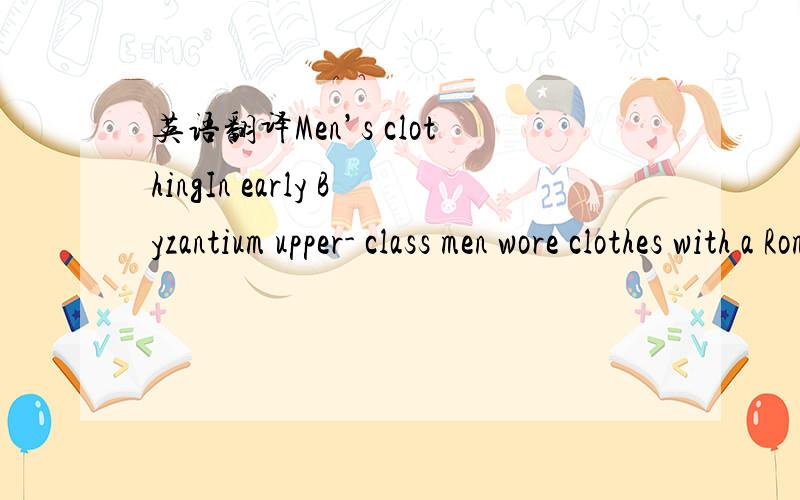英语翻译Men’s clothingIn early Byzantium upper- class men wore clothes with a Roman influence.The clothing was layered for concealment.First came the undergarment- a long sleeved,tight- fitting,ankle-or knee- length white tunic.A dalmatika- a t
来源:学生作业帮助网 编辑:作业帮 时间:2024/11/19 08:20:18

英语翻译Men’s clothingIn early Byzantium upper- class men wore clothes with a Roman influence.The clothing was layered for concealment.First came the undergarment- a long sleeved,tight- fitting,ankle-or knee- length white tunic.A dalmatika- a t
英语翻译
Men’s clothing
In early Byzantium upper- class men wore clothes with a Roman influence.The clothing was layered for concealment.First came the undergarment- a long sleeved,tight- fitting,ankle-or knee- length white tunic.A dalmatika- a tunic with long,wide sleeves- could be worn over the tunic or instead of it.So named because of its Dalmatian origins,the dalmatika was made of red and gold material.
Until the 6th century AD the toga was worn by most Byzantine citizens,but later only consuls could wear it and it was replaced by a cloak.There were three styles of cloak,all of Roman origin.Justinian is depicted wearing the first- a simple rectangle of fabric,floor- length when wrapped around the shoulders- on the mosaic in the church at San Vitale,Ravenna.A semi- circular cape which fastened at the shoulder was also worn .A circular cape- very much like the Roman paenula- was sewn up the front with an opening for the head,sometimes with a detachable hood.Another alternative to the toga was the Greek chlamys,which was often worn with a square piece of embroidered fabric called a tablion.
By the 5th and 6th centuries middle- class men wore the tunica.This featured a decorative neckline and was longer than the tunic worn by courtiers.Priests and noblemen also wore a pallium.Although this shares the same name as the Roman cloak,it was completely different,being a band of exquisitely decorated cloth,approximately 20cm (8in) wide,that was wrapped around the neck.
Under their tunic men also wore hosa (woollen or fabric hose) or braco (breeches).From the 6th century onwards men wore drawers or trousers.Labourers wore breeches that they tucked into their knee-length boots,covered by a thigh- grazing tunic and an ankle- length cloak,both made of simple,plain wool.
英语翻译Men’s clothingIn early Byzantium upper- class men wore clothes with a Roman influence.The clothing was layered for concealment.First came the undergarment- a long sleeved,tight- fitting,ankle-or knee- length white tunic.A dalmatika- a t
男士服装
在早期拜占庭上阶级的男子穿的衣服一个罗马的影响.服装是分层的隐蔽.首先是内衣-长袖,紧配合,ankle-or膝长度白色上衣.一个dalmatika-长袍宽袖,可以佩戴在外衣或取代它.如此命名是因为它的dalmatika达尔马提亚起源,是由红色和金材料.
直到公元第六世纪的袍子穿的是最拜占庭公民,但后来只有领事可以穿它,它取代了一个斗篷.有三种风格的斗篷,所有的罗马起源.查士丁尼是描绘穿着第一-一个简单的矩形的织物,地板的长度时,包裹周围的肩膀上镶嵌在教堂的圣维塔利,拉文纳.一个半圆形角,固定在肩膀也穿.一个圆形角-很像罗马带风帽大氅-缝前端有一个开放的头,有时可拆卸罩.另一个替代的官服是希腊栉,这往往是与方形的绣织物称为tablion.
在第五和第六世纪中类男人穿的.这种特色装饰领口和长于外套穿的朝臣.祭司和贵族也穿着一件披肩.虽然这股相同名称的罗马斗篷,这是完全不同的,是一个带精美的装饰布,约20厘米(8)宽,这是缠在了脖子.
在他们的外衣男子还穿着浩沙(羊毛织物软管)或布雷科(短裤).从第六世纪开始穿着抽屉或裤子.劳动者穿着马裤,他们藏到及膝靴,由大腿放牧外衣和踝长度的斗篷,用简单的,纯羊毛.
希望能帮到你!:-)↖(^ω^)↗